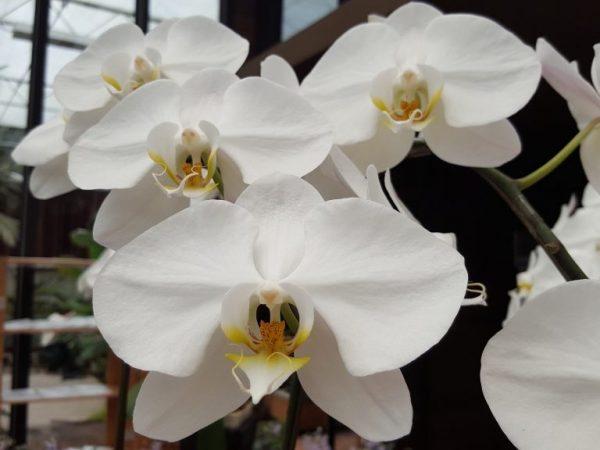Growing white Phalaenopsis
White Phalaenopsis is a symbol of harmony, pacification, therefore, brides prefer this particular flower to decorate the venue of the celebration, as well as to create a wedding bouquet. Umbrella often complements the composition in order to create a certified look.

Growing white Phalaenopsis
general characteristics
Phalaenopsis white orchid variety is the name of an incredibly beautiful plant, the distinctive features of which are:
- a high stem, the length of which is from 30 to 110 cm;
- the shape of the inflorescences visually resembles the wings of butterflies;
- rich green leaves;
- flowering frequency 7 times a year;
- well-developed root system, no bulbs.
The subtleties of growing
Varieties such as Phalaenopsis, during the growth period, require full compliance with temperature and light conditions.
The future location of the flower must meet the following conditions:
- good lighting, but the light should be diffused, because direct sunlight burns delicate white petals;
- sufficient ventilation: frequent drafts also negatively affect the health of the plant.
- temperature - from 16 ° С to 25 ° С.
Landing
The process of planting or transplanting a plant at home is carried out in several stages:
- First of all, the flower is removed from the old pot, being careful not to damage the root system.
- The roots are cleaned of the old soil mixture. To do this, the root ball is carefully straightened, large lumps of earth are removed from there.
- The cleaned orchid is placed in a pots with a new soil mixture and the roots are gradually covered with it.
Reproduction of orchids
Phalaenopsis reproduces vegetatively. The optimal period is late May-early June. Vegetative propagation consists in obtaining cuttings from the trunk and subsequent development.
Cutting procedure:
- removal of the bottom dry leaves;
- disinfection of wounds resulting from circumcision using activated carbon;
- after the formation of new root processes on the cuts, a secondary cutting of the already obtained cuttings is carried out.
After receiving the seedlings are planted in the ground, watering young plants is carried out as needed.
Care rules

An orchid requires careful maintenance
The white Phalaenopsis orchid is a plant that needs care. Without the right lighting and temperature, it is not possible to obtain fragrant white flowers.
Lighting
White varieties of orchids are photophilous. Without enough light, foliage will wither and fall off.
When grown at home, the following rules are observed:
- the sun's rays should be diffused, direct light contributes to the darkening of the white petals;
- in the summer they artificially create a shade to avoid burns;
- daylight hours - at least 12 hours a day; if necessary, special lamps are purchased for additional lighting.
Temperature regime
Large white Phalaenopsis are thermophilic varieties: the temperature is 30 ° C during the day and 18 ° C at night.The flower quickly adapts to room temperature.
Watering
The variety in question categorically reacts to excessively abundant watering, because the accumulation of water contributes to damage to the root, without which the flower is not able to exist. Abundant irrigation is necessary only during a period of active growth.
Under stable climatic conditions, irrigation is carried out 2 times a week. Take a container and pour purified, soft water into it, then place a pot in a container with water. So the flower drinks the amount of water it needs.
Top dressing
The orchid must be fertilized during the period of active growth and development 3 times a week. For the best effect, use specialized fertilizers "Pakun", "Bona Forte".
It is imperative to observe the proportions indicated on the package, because an excess of mineral salts negatively affects the Phalaenopsis root.
Pests and diseases
With proper care, the owners of Phalaenopsis manage to avoid problems, but there are a number of pests and diseases. These include rot, which forms as a result of improper irrigation. Treatment of such a problem is carried out in 2 stages:
- normalization of water balance;
- the use of a drug called "Fitosporin M".
Pests for this species are a rare occurrence, but when they are detected, a number of products are selected, the name of which will be suggested in a gardening store.
Conclusion
Phalaenopsis is an unpretentious plant. To eliminate the risk of pests or the formation of diseases, you must strictly follow the above recommendations. It is also very important to monitor the smallest changes in the appearance of the fragrant white flowers.


